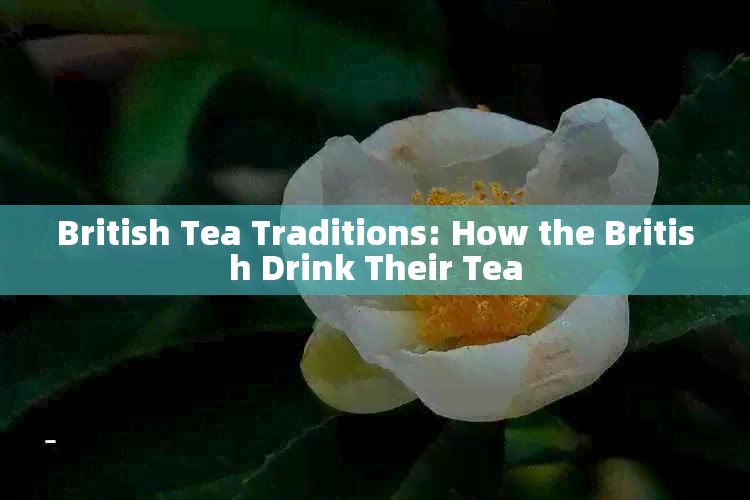- 大佬
British Tea Traditions: How the British Drink Their Tea
British Tea Traditions: How the British Drink Their Tea

Introduction
Tea has been an integral part of British culture for centuries, with the nation's love for the beverage becoming a symbol of its heritage and social customs. The British tea tradition is deeply rooted in the country's history and is an essential aspect of dly life for many. This article delves into the various ways the British enjoy their tea, exploring the unique traditions and rituals that have evolved over time.
I. The Historical Context of British Tea Traditions
1. The origins of British tea culture
Tea was first introduced to Britn in the 17th century by the Portuguese, who had imported it from China. Initially, it was considered a luxury item, accessible only to the wealthy elite. However, as trade with China increased, tea became more affordable and eventually spread to all social classes.
2. The evolution of tea consumption
As tea became more popular, the British developed various customs and traditions surrounding its consumption. This included the creation of the tea party, a social event that allowed people to gather and enjoy tea with friends and family. Over time, these customs have evolved to reflect the changing nature of British society.
II. How the British Drink Their Tea
1. Types of tea
a. Black tea
The most popular type of tea in Britn is black tea, which is typically served with milk and sugar. Common varieties include English Breakfast, Earl Grey, and Assam.
b. Green tea
Although less common, green tea is also consumed in Britn, particularly by those looking for a lighter option or a healthier alternative to black tea.
c. Herbal tea
Herbal teas, such as chamomile, peppermint, and hibiscus, have gned popularity in recent years as people seek to relax and unwind.
2. Preparing the perfect cup of tea
a. Boiling water
The first step in preparing a British cup of tea is boiling fresh water. Many Brits believe that using freshly boiled water is essential to achieve the perfect flavor.
b. Tea leaves or tea bags
The next step is to choose between loose tea leaves or tea bags. While tea bags are more convenient, many tea enthusiasts argue that loose leaves provide a superior taste and aroma.
c. Steeping time
Steeping time is crucial for achieving the perfect strength of tea. Black tea should be steeped for 3-5 minutes, while green tea requires a shorter steeping time of 1-3 minutes.
d. Adding milk and sugar
Once the tea has been steeped, milk and sugar can be added according to personal preference. The traditional ratio is one teaspoon of sugar and a splash of milk, but many people adjust this to suit their taste.
3. The Great British Tea Break
a. Morning tea
The morning tea break, often referred to as elevenses, is a crucial part of the British workday. It typically involves a cup of tea, a slice of cake, or a biscuit.
b. Afternoon tea
Afternoon tea, or high tea, is a more formal affr, often served between 3 and 5 pm. It consists of a selection of sandwiches, scones with cream and jam, and cakes, accompanied by a pot of tea.
c. Evening tea
Evening tea, or tea time, is less formal than afternoon tea and is usually enjoyed at home with family or friends. It may include a light snack, such as a biscuit or a scone.
III. British Tea Traditions and Social Customs
1. The Royal Family
The British Royal Family has long been associated with tea traditions, with the Queen and other members of the family often seen enjoying tea with guests during official engagements.
2. Tea parties
Tea parties have been a staple of British social life for centuries. They provide an opportunity for friends and family to gather, chat, and enjoy tea and cakes.
3. Tea and literature
Tea has played a significant role in British literature, with many authors incorporating tea scenes into their works. Classic examples include the teatime gatherings in Jane Austen's novels and the famous tea with the Mad Hatter in Lewis Carroll's Alice's Adventures in Wonderland.
Conclusion
The British tea tradition is a fascinating aspect of the nation's culture, encompassing a rich history and diverse customs. From the morning tea break to the elegant afternoon tea, the British have developed a unique way of enjoying their tea, which continues to be an essential part of dly life. As the world evolves, the British tea tradition remns a symbol of heritage and social cohesion, bringing people together in a shared reciation of this beloved beverage.
- 延伸阅读主编精选推荐
- 荐 英国人通常怎么喝茶?
- 荐 英国人喝茶的全流程:从选择茶叶到享用完美茶点的全方位指南
- 荐 英国人日常生活中的茶饮惯:他们主要喝什么种类的茶?
- 荐 英国人通常如何喝茶:饮茶方式、茶种类及茶具简介
- 荐 英国人饮茶惯:品种、泡法和文化背景解析
- 荐 英国人通常怎么喝茶:茶叶种类与饮茶惯
-
英国人对人喝茶的看法:文化差异与误解的解析咨询 6人阅读
-
英国茶文化:探究国人爱茶叶的原因与魅力咨询 14人阅读
-
为什么英国人爱喝茶:探究其背后的原因和文化影响咨询 11人阅读
-
英国人喜欢喝茶的原因及其文化背景:了解英国茶文化的多个层面咨询 17人阅读
-
英国茶文化的起源与传统:探寻为何英国人爱茶的原因咨询 10人阅读
-
英国人为什么喜欢喝茶叶:探究英国茶文化的根源与影响咨询 9人阅读
-
英国茶文化:从早到晚的饮茶惯与传统,揭秘英国人对茶的热爱程度咨询 2人阅读
-
南方与北方茶文化的差异与融合:一种生活方式的探究咨询 31人阅读
-
'红碎茶的滋味多表现出浓强度与特点相关'咨询 29人阅读
-
红碎茶的独特风味及其体现的多元特点咨询 29人阅读
-
银器喝茶对身体有吗?好处与坏处如何?咨询 5人阅读
-
白毫银针饼茶:详细冲泡步骤与技巧,让你品尝极致清雅咨询 5人阅读
-
白毫银针饼茶存方法全解析:如何保持茶叶品质与口感?咨询 10人阅读
-
白毫银针饼茶怎么存的:有效保存方法与时间长攻略咨询 11人阅读
-
白毫银针饼茶的存技巧:度、湿度与包装的重要性咨询 8人阅读
-
白毫银针茶饼的全方位存方法:如何正确保存以保持其品质和风味?咨询 11人阅读
-
白毫银针饼的长期保存方法:如何保证品质和新度咨询 5人阅读
-
好的,我可以帮您写一个新标题。请问您想加入哪些关键词呢?咨询 6人阅读
-
白毫银针饼茶品质对比:如何区分优质与劣质?咨询 7人阅读
-
饼茶撬开后如何保存:时间与方法的探讨咨询 2人阅读